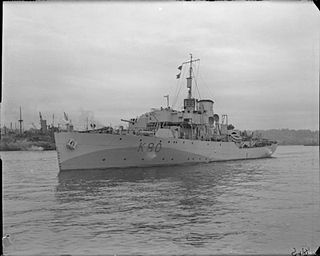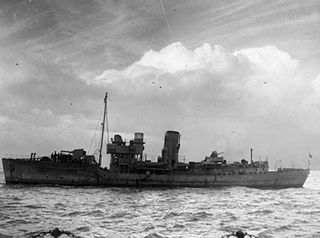
The Flower-class corvette was a British class of 294 corvettes used during World War II by the Allied navies particularly as anti-submarine convoy escorts in the Battle of the Atlantic. Royal Navy ships of this class were named after flowers.

HMS Bluebell was a Flower-class corvette that served in the Royal Navy in World War II. Ordered from Fleming & Ferguson of Paisley, Scotland on 27 July 1939, she was launched on 24 April 1940 and commissioned in July 1940. She served in the Atlantic, Mediterranean and Arctic campaigns, escorting several convoys to Russia, and also took part in the invasions of Sicily and France. She was torpedoed and sunk by U-711 in the Kola Inlet on 17 February 1945 while escorting the convoy RA 64 from Murmansk. Only one member of her crew survived.

HMCS Alberni was a Flower-class corvette that served in the Royal Canadian Navy (RCN) during the Second World War. The Flower-class corvettes were warships designed for anti-submarine warfare. The ship was constructed by Yarrows Ltd. in Esquimalt, British Columbia, laid down on 19 April 1940, launched on 22 August and commissioned on 4 February 1941. The corvette sailed east to join the RCN's fleet in the Atlantic via the Panama Canal, where upon arrival, the vessel began escorting trans-atlantic convoys in the Battle of the Atlantic. Alberni took part in the key convoy battle of Convoy SC 42. In 1942, the corvette was transferred to Allied convoy assignments associated with Operation Torch in the Mediterranean Sea. In 1944, Alberni was among the Canadian naval vessels assigned to Operation Neptune, the naval component of the invasion of Normandy and escorted support ships to and from the United Kingdom on D-day.

HMS Leith was a Grimsby-class sloop of the Royal Navy that served in the Second World War.

USS Surprise (PG-63), the fourth American naval ship of the name, was a Temptress-class patrol gunboat during World War II. She was built as the British Flower-class corvette HMS Heliotrope, and was in service with the Royal Navy during the first years of the Battle of the Atlantic. She was loaned to and operated by the United States Navy from 1942 to 1945. After World War II, she was sold as a merchant vessel and ended her life in the Chinese navy as Lin I.
When the United States entered World War II at the end of 1941, the United States Navy found itself deficient in ocean escort-type vessels. A crash building program was instituted; but, to meet more immediate needs, the government contracted with shipbuilding firms in England and Canada to build Flower-class corvettes. Vim (PG-99) was one of those British-type escorts. She was launched on 1 April 1943 at the Collingwood Shipyard in Collingwood, Ontario. Nine days later, however, she was transferred to the Royal Navy under the terms of the lend-lease agreement in return for another Flower-class corvette then under construction in Canada. The British renamed her HMS Statice, and she served the Royal Navy under the name through World War II. On 21 June 1946, she was returned to the United States Navy. Though carried on the Navy list as PG-99, the corvette never saw active service with the United States Navy. She was sold on 7 May 1947. To whom she was sold and to what purpose she was put is unknown.

HMCS Battleford was a Flower-class corvette of the Royal Canadian Navy launched on 15 April 1940 and commissioned on 31 July 1941 during the Second World War. The corvette served primarily in the Battle of the Atlantic, escorting convoys of merchant ships. After the war she was sold to the Venezuelan Navy and renamed Libertad. Libertad was wrecked on 12 April 1949.

HMCS Fredericton was a Flower-class corvette of the Royal Canadian Navy. She was ordered from Marine Industries Ltd. in Sorel, Quebec and laid down on 22 March 1941. She was launched on 2 September 1941 and commissioned on 8 December 1941. She was named after the community of Fredericton, New Brunswick.

HMS Wanderer (D74/I74) was an Admiralty modified W class destroyer built for the Royal Navy. She was the seventh RN ship to carry the name Wanderer. She was ordered in January 1918 to be built at the Fairfield Shipbuilding and Engineering Company, Govan in Glasgow, being launched in May 1919. She served through World War II where she was jointly credited with five kills on German U-boats, more than any other ship of her class. In December 1941 the community of Sutton Coldfield in Warwickshire officially adopted her. In 1943 she was one of twenty one V&W class destroyers to be converted as Long Range Escorts. She was decommissioned after the war and sold for scrap in 1946.

HMS Rochester (L50) was a Shoreham-class sloop of the Royal Navy. She served during the Second World War and was a successful anti-submarine warfare vessel, being credited with the destruction of five U-boats.

HMS Delphinium (K77) was a Flower-class corvette built for the Royal Navy (RN) from 1940-1946. From 1941 to 1943 she was active in the Mediterranean as an escort to convoys supporting the Eighth Army and the invasion of Sicily. From mid-1943 onwards she was on convoy escort duties between Africa, the Mediterranean and the United Kingdom; and Atlantic convoys between North America and the United Kingdom. She escorted a total of 68 convoys.

HMS Hibiscus was a Flower-class corvette, built for the Royal Navy during the Second World War, and was in service in the Battle of the Atlantic. In 1942 she was transferred to the United States Navy as part of the Reverse Lend-Lease arrangement and renamed USS Spry, one of the Temptress-class gunboats. With the end of hostilities she was returned to the Royal Navy and sold into mercantile service.

HMS Periwinkle was a Flower-class corvette, built for the Royal Navy during the Second World War, and was in service in the Battle of the Atlantic. In 1942 she was transferred to the United States Navy as part of the Reverse Lend-Lease arrangement and renamed USS Restless, one of the Temptress-class gunboats. With the end of hostilities she was returned to the Royal Navy and sold into mercantile service.
HMS Erica was a Flower-class corvette that served in the Royal Navy and was built by Harland and Wolff in 1941. She was named after Erica. Commissioned in 1940 and sunk by a mine on 9 February 1943.
HMS Snapdragon was a Flower-class corvette that served in the Royal Navy and was built by Smith's Dock Company in 1940. She was named after Snapdragon. Commissioned in 1940 and sunk by Luftwaffe on 19 December 1942.
HMS Auricula was a Flower-class corvette that served in the Royal Navy and was built by George Brown and Company in 1940. She was named after Auricula. Commissioned in 1941 and sunk by a mine on 6 May 1942.

HMS Asphodel was a Flower-class corvette that served in the Royal Navy and was built by George Brown and Company in 1940. She was named after Asphodel. Commissioned in 1940 and sunk by U-575 on 10 March 1944.

HMS Gardenia was a Flower-class corvette that served in the Royal Navy and was built by William Simons and Company in 1940. She was named after Gardenia. Commissioned in 1940, rammed and sunk by HMS Fluellen on 9 November 1942.
HMS Fleur de Lys was a Flower-class corvette that served in the Royal Navy and was built by Smith's Dock Company in 1940. She was named after Fleur de Lys. Commissioned in 1940, rammed and sunk by U-206 on 14 October 1941. Her name was originally La Dieppoise and built for the French Navy but was later changed.

HMS Petunia (K79) was a Flower-class corvette that served in the Royal Navy and was built by Henry Robb in 1940. She was named after Petunia. Commissioned in 1940, rammed and sold to the Chinese Nationalist Government and renamed ROCS Fu Bo.















